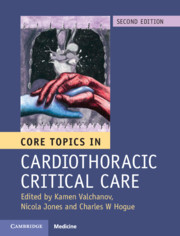Book contents
- Core Topics in Cardiothoracic Critical Care
- Core Topics in Cardiothoracic Critical Care
- Copyright page
- Contents
- Contributors
- Foreword
- Preface to the Second Edition
- Link between Cardiothoracic Anaesthesia and Intensive Care: Which Patients are Admitted to Critical Care?
- Scoring Systems and Prognosis
- Abbreviations
- Section 1 Diagnosis
- Section 2 Practical Procedures
- 8 Airway Management in Cardiothoracic Intensive Care: Intubation and Tracheostomy
- 9 Chest Drainage
- 10 Cardiac Pacing and Defibrillation
- 11 Arterial and Venous Catheterisation and Invasive Monitoring
- Section 3 Therapeutic Intervention
- Section 4 Advanced Organ Support
- Section 5 Acute Disorders
- Section 6 Perioperative Care: The Patient Post Cardiac Surgery
- Section 7 Disease Management in the Cardiothoracic Intensive Care Unit: Incidence; Aetiology; Diagnosis; Prognosis; Treatment
- Section 8 Provision and Delivery of Cardiothoracic Intensive Care
- Exercise Answers
- Index
- References
10 - Cardiac Pacing and Defibrillation
from Section 2 - Practical Procedures
Published online by Cambridge University Press: 15 June 2018
- Core Topics in Cardiothoracic Critical Care
- Core Topics in Cardiothoracic Critical Care
- Copyright page
- Contents
- Contributors
- Foreword
- Preface to the Second Edition
- Link between Cardiothoracic Anaesthesia and Intensive Care: Which Patients are Admitted to Critical Care?
- Scoring Systems and Prognosis
- Abbreviations
- Section 1 Diagnosis
- Section 2 Practical Procedures
- 8 Airway Management in Cardiothoracic Intensive Care: Intubation and Tracheostomy
- 9 Chest Drainage
- 10 Cardiac Pacing and Defibrillation
- 11 Arterial and Venous Catheterisation and Invasive Monitoring
- Section 3 Therapeutic Intervention
- Section 4 Advanced Organ Support
- Section 5 Acute Disorders
- Section 6 Perioperative Care: The Patient Post Cardiac Surgery
- Section 7 Disease Management in the Cardiothoracic Intensive Care Unit: Incidence; Aetiology; Diagnosis; Prognosis; Treatment
- Section 8 Provision and Delivery of Cardiothoracic Intensive Care
- Exercise Answers
- Index
- References
- Type
- Chapter
- Information
- Core Topics in Cardiothoracic Critical Care , pp. 77 - 85Publisher: Cambridge University PressPrint publication year: 2018



